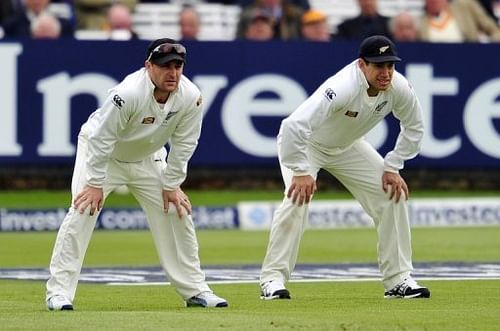
Anderson bowls England back into first Test
LONDON (AFP) –

England cricketer James Anderson (R) appeals unsuccessfully for the wicket of New Zealand’s Kane Williamson during the second day of the first International Test cricket match between England and New Zealand at Lord’s cricket ground in London on May 17, 2013. The second day ended with New Zealand 153 for four in reply to England’s first innings 232, a deficit of 79 runs.
James Anderson took his 300th Test wicket and then ended a bold counter-attack by New Zealand’s Ross Taylor as England fought back in the first Test at Lord’s.
The two players lit up a Lord’s bathed in artificial floodlight to counter the overhead gloom of Friday’s second day, which ended with New Zealand 153 for four in reply to England’s first innings 232 — a deficit of 79 runs.
Anderson took the first three wickets to fall, reducing the Black Caps to seven for two before dismissing Taylor for a scintillating 66.
“I’m quite happy I’ve got it out of way the early and can move on now and think about something else,” Anderson told reporters after stumps.
The 30-year-old, in his 81st match at this level, did not have long to wait for his 299th Test wicket after taking the new ball.
One ball after Hamish Rutherford had cover-driven him for four, Anderson squared him up with an outswinger and England captain Alastair Cook, diving to his right, held an excellent low catch at first slip.
Anderson struck again when Peter Fulton, the tourists’ other opener, nicked a good length ball low to second slip Graeme Swann as the Lancashire seamer became only the fourth England bowler after Fred Trueman, Bob Willis and Ian Botham to take 300 Test wickets.
New Zealand were now in dire straits, with Anderson’s purple patch yielding two wickets for no runs in 17 balls.
Taylor, however, responded with the innings of the match so far, stroking 13 boundaries — only eight fewer than England managed in their entire innings.

Brendon McCullum (L) and Ross Taylor stand in the slips at Lord’s on May 17, 2013. The second day ended with New Zealand 153 for four in reply to England’s first innings 232, a deficit of 79 runs.
He was especially severe on Stuart Broad, cutting and cover-driving the fast bowler for two fours in as many balls.
However, a partnership of 93 with Kane Williamson (44 not out) ended when Taylor was lbw to Anderson to leave the tourists 100 for three.
“I think the way they batted they were timid but at seven for two the momentum was back with them,” said Taylor.
“I didn’t intend to counter-attack, I just wanted to be positive and play as straight as possible. When you have that positive intent the looser balls come into your area.”
Anderson should have had a fourth wicket when Williamson, on 23, edged a full length ball but wicket-keeper Matt Prior, diving to his right, dropped a low one-handed chance.
New Zealand did lose another wicket when fast bowler Steven Finn, on his Middlesex home ground, had Dean Brownlie lbw for 23 following a review of Australian umpire Steve Davis’s original not out decision.
“They are all important wickets,” said Anderson.
“Finny’s wicket at the end of the day was very important for us because they were starting to build a partnership and we needed to get back in the game.
“That’s done that and now we know we’ve got a chance tomorrow (Saturday) morning if we bowl well to make further inroads.”
Kiwi captain Brendon McCullum was one not out when the umpires finally decided the light was no longer playable and drew stumps.

Tim Southee (R) celebrates taking the wicket of Matt Prior (L) at Lord’s on May 17, 2013. The second day ended with New Zealand 153 for four in reply to England’s first innings 232, a deficit of 79 runs.
Taylor’s was the first fifty of the match following an England innings where Jonny Bairstow top-scored with 41.
Tim Southee, who removed Joe Root and Prior with successive deliveries, led New Zealand’s attack with four for 58 after England, who continued to find scoring difficult, resumed on 160 for four.
Southee made the breakthrough after an hour Friday with a bad ball that Root, on 40, obligingly glanced down the legside to wicket-keeper BJ Watling.
Prior had frustrated New Zealand with an unbeaten hundred that ensured a draw and a 0-0 result in a three-match series when the teams last met in Auckland in March.
But he was lbw first ball Friday to Southee.
Stuart Broad survived the hat-trick but was soon plumb lbw for nought to left-arm seamer Neil Wagner.
Bairstow was last man out, caught and bowled by Southee after nearly three hours’ resistance.